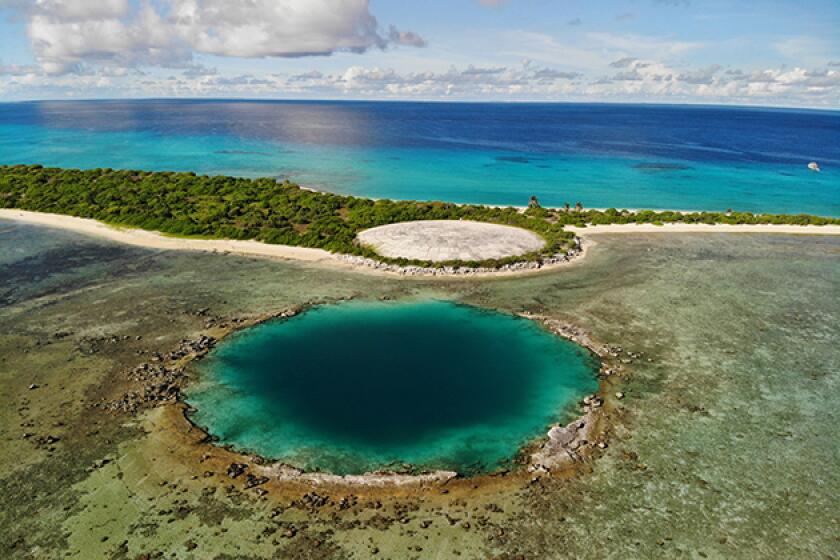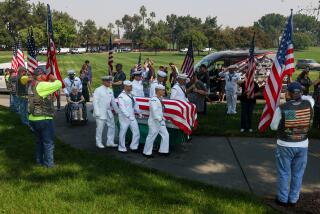He saw a Marshall Islands nuclear bomb test up close. It’s haunted him since 1952

- Share via
MENLO PARK, Calif. — In the summer of 1952, Alan Jones, an industrious redhead with an impish smile, yearned for excitement and adventure. He drove down the California coast from Berkeley to La Jolla, hoping to join an oceanographic expedition heading to the South Pacific.
It wasn’t until he was preparing to board the Scripps Institution of Oceanography’s research vessel, a rusty old tuna hauler called the Horizon, that he discovered the mission involved more than mapping the ocean floor: The crew of PhDs and handy guys like Jones, who “could fix things,” was going to the Marshall Islands to record waves generated by the world’s first hydrogen bomb.
Six months later, on Nov. 1, after watching an island get vaporized, Jones and the crew on the Horizon were doused in a shower of radioactive fallout. It was an incident that lowered Jones’ ability to produce blood platelets for two years, he believes, and he now wonders whether it caused developmental disabilities in a son born later, as well as his wife’s miscarriages and stillbirths.
“We didn’t think of it then,” he said in August at his home in Menlo Park, Calif., as he looked down into his lap, where his hands lay folded. “But maybe that’s why.”
Jones was one of just a few civilian witnesses to the event, and it left him shaken — even seven decades later — as he recalls how ill-prepared his boat and crew were for the bomb’s fallout.
“Our boat was too slow to get out of the way,” he said, noting that while every other boat there that day was more than 100 miles from the blast, the Horizon was just 72 miles away, according to military documents.
Jones’ interest in the expedition was kindled during his senior year at UC Berkeley, when he attended a lecture by Roger Revelle, Scripps’ director and the grandfather of climate change science.
The topic: a 1950 scientific expedition to the Marshall Islands.
Over the course of three months, Revelle and his team of scientists, technicians and undergraduates from Scripps had traversed 25,000 miles of warm, tropical Pacific waters, mapping the ocean’s floor as they cruised over never-before-seen underwater mountain ranges and caverns.
He said he was about to embark on another expedition that fall. The day after graduation, Jones hopped in his car and drove the 500 miles to La Jolla.
“I had no idea if he’d take me,” recalled Jones, now 92 and a retired United States Geological Survey seismologist. “But he did.”
On Sept. 26, 1952, the Horizon embarked on a five-month Pacific voyage with a crew of 13 scientists and 20 crew members.
The accounts from Jones and Edward “Ned” Barr, who was the youngest researcher on the boat at 19, are the only two the Times could locate. Barr lives in San Diego and could not be reached for comment. Copies of his diary were obtained through Jones and the Scripps Institution archives.
The journey to the Marshall Islands took three weeks. Jones remembers working the whole time, readying the recording equipment — but there was also plenty of time for frivolity and laughter.
According to diary entries of Barr, a scientific crew member and Stanford University student at the time, he recalls shooting ocean debris with .22-caliber rifles and shotguns, singing spoofs on Wagner’s arias at night, and reading and writing chapters of a multiauthored “superdooper sex story” titled “Of Restless Nights,” which crew members consumed during their lonely night watches.
On Oct. 15, the Horizon reached Enewetak Atoll, in the northern Marshall Islands, and was navigated through the atoll’s narrow pass by a Navy harbor pilot. Before they could enter, though, they received orders to stow away all cameras and writing materials — they were strictly forbidden.
“This news made me feel a bit uneasy,” Barr wrote, “but I decided to be very discreet about my diary and picture-taking. I reasoned that if no one keeps a written chronology of this event, history would ultimately become more important than the fear of the Russians!”
For the next few weeks, the crew ferried around Enewetak Atoll, laying cables along the lagoon floor, erecting recording platforms at various points and observing the native and not-so-native fauna that populated the islands.
“Rats on this island are numerous. As one walks in the evening along paths … the rats run in front of you in herds by the hundreds,” Barr wrote.
As the nuclear test day approached, the crew members of the Horizon prepared. Barr and a fellow crew member, Bernard Darsey, were dropped off on Jelete Island, in Bikini Atoll, more than 100 miles away. The others stayed on board the Horizon, in Enewetak, making last-minute adjustments and running tests.
On Oct. 31, the night before detonation, Barr and his co-islander pondered the uncertain and momentous test they were about to witness: “Now it was time for the ultimate corroboration of scientific extrapolation,” Barr wrote.
The two took Benzedrine to keep alert; they didn’t want to get caught sleeping on the job. And they reviewed their orders: Barr was told that at blast time, he should be “standing outside the tent facing the bomb with my feet and lower legs buried in tightly-packed sand.” That apparently was to protect him from being tossed off the island by a shock wave.
Once interred, he was to wait for a radio signal: If he heard “ABLE ABLE ABLE,” it would mean that a tidal wave was coming and he was to find the tallest coconut tree, climb and hold on for dear life.
If he heard “BRAVO BRAVO BRAVO,” he should still climb a tree, but the wave would wipe out only the nearby islands.
If, however, he heard “CHARLIE CHARLIE CHARLIE,” a smallish wave was on its way, and he should get out of the sand and move to higher ground. If the signal was “DOG DOG DOG,” he didn’t have to move at all.
A little after 6 a.m., the two men walked to the beach, dug their respective holes, buried their legs in tight and waited.
At 6:30, Barr, Darsey and the crew of the Horizon — who were floating just 72 miles north of the blast — heard the countdown and then saw the morning sky light up in a fury. Jones remembers it being a “great orange fireball,” while Barr, in his diary, described it as “a bright pink illumination” that shot outward and then “upward, making everything bright red.”
A few minutes later, the sound hit. Jones recalls a boom, which he said ricocheted with 17 thunderclaps as it bounced between the stratosphere and ocean. According to Barr, it “was totally awesome. It was deafening. It was magnificent. It was like the sound of one hundred thunder storms coming at us from all directions.”
“It would seem that the heavens would burst,” he wrote. “We all stood in stunned awe before the largest display of man’s use of the Hydrogen Atom. For minutes the holocaust of sound continued, thereafter gradually subsiding. Earaches and ringing sensation were experienced for many hours.”
As Barr eyed the nearby palm trees, assessing their height and strength, Jones noticed huge clouds forming in the sky, and then a “darkness” that rushed toward the Horizon.
According to military documents, the Horizon was close at 72 miles and downwind, in an area vulnerable to radioactive fallout.
“We were in the wrong place at the wrong time,” said Jones, who remembers racing below deck with the rest of the crew, sealing the portholes and doors, and shutting down the air and ventilation systems. The cloud unleashed, and for the next couple of hours, the Horizon was pelted by a storm of fallout. “In the confusion, we actually started motoring toward the blast; it took about an hour before we realized we were going the wrong way,” Jones said.
As the crew waited out the storm, finally heading away, the lower deck became hot, stuffy and humid; even though the air conditioning had been turned off, the boat’s machinery kept running.
“It was insufferable,” said Jones, who remembers having to stay below deck for more than 24 hours. The radiation meters the Navy had ordered them to wear spiked, and there were rapid-fire sounds from the Geiger counter that the onboard Navy observer was holding, he recalled.
When they were finally given the all-clear, they realized everything on the deck was contaminated, Jones said. The boat’s sprinkler system — which was designed to wash the boat in such a scenario — used seawater for decontamination. But the ocean water surrounding the boat was contaminated.
The crew had to throw everything on the deck overboard.
Jones has no idea how badly he was exposed that day — the naval officer onboard took away his radiation meter, which he said had maxed out. But he knew he had no interest in staying any longer.
The Horizon was scheduled to stay for a second test, but Jones opted instead to hop on another Scripps boat, the Spencer F. Baird, that was coming into the Marshalls and then heading to Fiji, Tonga, Samoa and the Marquesas. Barr also decided to leave.
According to Jones, many of the crew members who stayed ended up dying early of cancer. The Times was unable to confirm his claim.
As for his own health, Jones said, his blood platelets dropped precipitously after his exposure, and for the next two years he had to get monthly iron and B12 shots, “which seemed to work quite fine.”
He wasn’t allowed to discuss the event with his physician or provide any information that may have helped his doctor understand what was happening, although “he figured it out,” Jones said.
Jones doesn’t know how else the radiation may have affected him, though he acknowledged that it didn’t affect his longevity.
But he does wonder about his children. He said his wife had many miscarriages and stillbirths. And the one son who survived was severely developmentally delayed, he said. His wife and son are no longer alive.
Asked whether he’d do it all again, he shrugged. The expedition around the South Pacific, he said, was incredible. But the bomb was terrifying — and he worries someday a country will use one again.
“Those things will destroy us,” he said. “They are a terrible force.”
More to Read
Sign up for Essential California
The most important California stories and recommendations in your inbox every morning.
You may occasionally receive promotional content from the Los Angeles Times.












